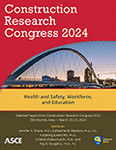A Conceptual Framework for Implementing Passive Wearable Robots in the Construction Industry
Publication: Construction Research Congress 2024
ABSTRACT
Wearable robots have the potential to address the occurrence of work-related musculoskeletal disorders in the construction industry. However, sparse evidence is available on how to implement these technological interventions in construction organizations. Therefore, this study aims to develop an implementation strategy to aid the adoption of wearable robots in the construction sector. An online survey was conducted to identify the factors (i.e., facilitators and barriers) and stakeholders that could influence the adoption of wearable robots. Using the results of the survey, constructs from normalization process theory, and literature review, an implementation strategy was developed. A four-step framework was formulated, which includes organizational decision on the implementation of exoskeleton, operational strategy, creating buy-in and training, and deployment monitoring. The study proposes one of the first conceptual frameworks to guide construction companies in the implementation of wearable robots.
Get full access to this article
View all available purchase options and get full access to this chapter.
REFERENCES
Adabre, M. A., and Chan, A. P. C. (2019). “Critical success factors (CSFs) for sustainable affordable housing.” Building and Environment, 156, 203–214.
Arayici, Y., Khosrowshahi, F., Ponting, A. M., and Mihindu, S. (2009). “Towards implementation of building information modelling in the construction industry.” Proc., Proceedings of the fifth international conference on construction in the 21st century: Collaboration and integration in engineering, management and technology, 1342–1351.
Bevan, S. (2015). “Economic impact of musculoskeletal disorders (MSDs) on work in Europe.” Best Practice & Research Clinical Rheumatology, 29(3), 356–373.
Boschman, J. S., van der Molen, H. F., Sluiter, J. K., and Frings-Dresen, M. H. (2012). “Musculoskeletal disorders among construction workers: a one-year follow-up study.” BMC musculoskeletal disorders, 13, 1–10.
Feldmann, C., Kaupe, V., and Lucas, M. (2020). A procedural model for exoskeleton implementation in intralogistics. In Data Science and Innovation in Supply Chain Management: How Data Transforms the Value Chain. Proceedings of the Hamburg International Conference of Logistics (HICL), Belin. 29, 113–151.
Finch, T. L., Mair, F. S., O’Donnell, C., Murray, E., and May, C. R. (2012). “From theory to’measurement’in complex interventions: methodological lessons from the development of an e-health normalisation instrument.” BMC medical research methodology, 12(1), 1–16.
Gonsalves, N., Akanmu, A., Shojaei, A., Agee, P., and Gao, X. (2023). “Adoption of Passive Wearable Robots in the Construction Industry: Barriers and Facilitators.” Journal of Civil Engineering and Management. Under Review.
Gonsalves, N. J., Ogunseiju, O. R., Akanmu, A. A., and Nnaji, C. A. (2021). “Assessment of a passive wearable robot for reducing low back disorders during rebar work.” ITcon, 26, 936–952.
Gonsalves, N. J., Yusuf, A., Ogunseiju, O., and Akanmu, A. (2023). “Evaluation of concrete workers’ interaction with a passive back-support exoskeleton”, Engineering, Construction and Architectural Management, Vol. ahead-of-print No. ahead-of-print.
Grol, R., and Wensing, M. (2004). “What drives change? Barriers to and incentives for achieving evidence‐based practice.” Medical Journal of Australia, 180, 57–60.
Howard, J., Murashov, V. V., Lowe, B. D., and Lu, M. L. (2020). “Industrial exoskeletons: Need for intervention effectiveness research.” American journal of industrial medicine, 63(3), 201–208.
Kim, S., Moore, A., Srinivasan, D., Akanmu, A., Barr, A., Harris-Adamson, C., Rempel, D. M., and Nussbaum, M. A. (2019). “Potential of Exoskeleton Technologies to Enhance Safety, Health, and Performance in Construction: Industry Perspectives and Future Research Directions.” IISE Transactions on Occupational Ergonomics and Human Factors, 7(3-4), 185–191.
Mahmud, D., Bennett, S. T., Zhu, Z., Adamczyk, P. G., Wehner, M., Veeramani, D., and Dai, F. (2022). “Identifying Facilitators, Barriers, and Potential Solutions of Adopting Exoskeletons and Exosuits in Construction Workplaces.” Sensors, 22(24), 9987.
McEvoy, R., Ballini, L., Maltoni, S., O’Donnell, C. A., Mair, F. S., and MacFarlane, A. (2014). “A qualitative systematic review of studies using the normalization process theory to research implementation processes.” Implementation Science, 9, 1–13.
Ngai, E. W. T., To, C. K. M., Moon, K. K. L., Chan, L. K., Yeung, P. K. W., and Lee, M. C. M. (2010). “RFID systems implementation: a comprehensive framework and a case study.” International Journal of Production Research, 48(9), 2583–2612.
Nnaji, C., and Awolusi, I. (2021). “Critical success factors influencing wearable sensing device implementation in AEC industry.” Technology in Society, 66, 101636.
Okpala, I., Nnaji, C., and Awolusi, I. (2019). “Emerging construction technologies: State of standard and regulation implementation.” In Cho, Y. K., Leite, F., Behzadan, A., and Wang, C. (Eds). Computing in civil engineering 2019: Data, sensing, and analytics, American Society of Civil Engineers Reston, VA, 153–161.
Silverio-Fernández, M. A., Renukappa, S., and Suresh, S. (2021). “Strategic framework for implementing smart devices in the construction industry.” Construction Innovation, 21(2), 218–243.
Information & Authors
Information
Published In
History
Published online: Mar 18, 2024
ASCE Technical Topics:
Authors
Metrics & Citations
Metrics
Citations
Download citation
If you have the appropriate software installed, you can download article citation data to the citation manager of your choice. Simply select your manager software from the list below and click Download.
